Hello!
I am a Horn player, and know little about woodwinds.
My wife recently acquired the instrument in these pictures at an estate auction.
It is 19.5 inches long, has 7 holes (6 on top, one below) and 6 keys. It is conical. The mouthpiece receiver looks like one for a double reed, but it had a small single reed mouthpiece attached. An oboeist in my band believes it is a clarinet, my band director says it’s an early oboe.
Any thoughts/opinions/suggestions would be appreciated!
Thanks…
I am a Horn player, and know little about woodwinds.
My wife recently acquired the instrument in these pictures at an estate auction.
It is 19.5 inches long, has 7 holes (6 on top, one below) and 6 keys. It is conical. The mouthpiece receiver looks like one for a double reed, but it had a small single reed mouthpiece attached. An oboeist in my band believes it is a clarinet, my band director says it’s an early oboe.
Any thoughts/opinions/suggestions would be appreciated!
Thanks…
Attachments
-
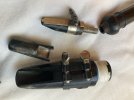 08A58411-3E6C-45A0-80C6-8C7F001C8919.jpeg1.6 MB · Views: 150
08A58411-3E6C-45A0-80C6-8C7F001C8919.jpeg1.6 MB · Views: 150 -
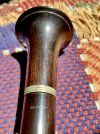 76B64226-D35B-44A5-B43A-883584A1E0AB.jpeg2.6 MB · Views: 160
76B64226-D35B-44A5-B43A-883584A1E0AB.jpeg2.6 MB · Views: 160 -
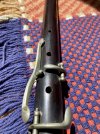 97C19177-A581-4AF9-83BC-771D85514694.jpeg3.7 MB · Views: 175
97C19177-A581-4AF9-83BC-771D85514694.jpeg3.7 MB · Views: 175 -
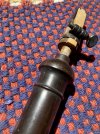 921EC563-8AF3-445A-9363-1C62F885447B.jpeg3.4 MB · Views: 162
921EC563-8AF3-445A-9363-1C62F885447B.jpeg3.4 MB · Views: 162 -
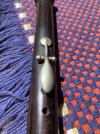 BE3AB325-ADEE-44EE-A1B7-08EF52DEFD2E.jpeg3.5 MB · Views: 143
BE3AB325-ADEE-44EE-A1B7-08EF52DEFD2E.jpeg3.5 MB · Views: 143 -
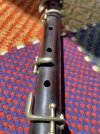 57BBE77D-0EA9-4BEB-90D9-4105D2EC2E91.jpeg2.3 MB · Views: 142
57BBE77D-0EA9-4BEB-90D9-4105D2EC2E91.jpeg2.3 MB · Views: 142 -
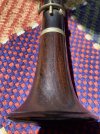 3574B004-83B0-4AA7-8935-3B9FEEE52B50.jpeg3 MB · Views: 149
3574B004-83B0-4AA7-8935-3B9FEEE52B50.jpeg3 MB · Views: 149 -
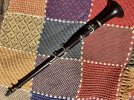 007DA43A-AB66-41FA-B2D8-AC7E5E6999EE.jpeg7.2 MB · Views: 156
007DA43A-AB66-41FA-B2D8-AC7E5E6999EE.jpeg7.2 MB · Views: 156
